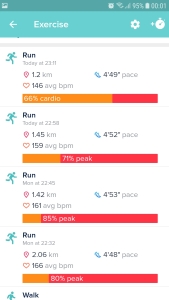These are the values I get on my 3rd day of running, after a long break:
- 4’48” or 12.5 km/h (= 60/4’48”) for distance 2.06km
- 4’53” or ~12.29 km/h for distance 1.42km
- 4’52 or ~12.32 km/h for distance 1.45km
- 4’49” or ~12.47 km/h for distance 1.2km

The question is, what’s the average pace based on this information?
The intuitive (and incorrect) way is to sum the 4 paces outright and divide them by 4, i.e. to get to around 12.395 km/h.
This is incorrect because each pace takes a different distance portion of the overall distance covered. Think of pie charts, or pizzas. When we do the simple average we assume all slices cover the same area, but that is not true in this case.
The total distance is 2.06 + 1.42 + 1.45 + 1.2 which is 6.13km. Thus the first pace covers 2.06/6.13 (or about 33%), the second pace 1.42/6.13 (or about 23.16%), etc. So we’d multiply every pace by its corresponding percentage, and taking the sum of all such entries will produce the required result.
In general, we want to come up with a generalized formula such that each element in the average formula has its own weight.
Thus, the formula for generalized average is: , where
In our specific example, we have that:
Thus, calculating the sum leads to ~12.4 km/h, which is 0.005 difference from the previous value for this specific case. Note that the difference may turn out to be even bigger depending on the slice portions.
One thought on “Generalized average”